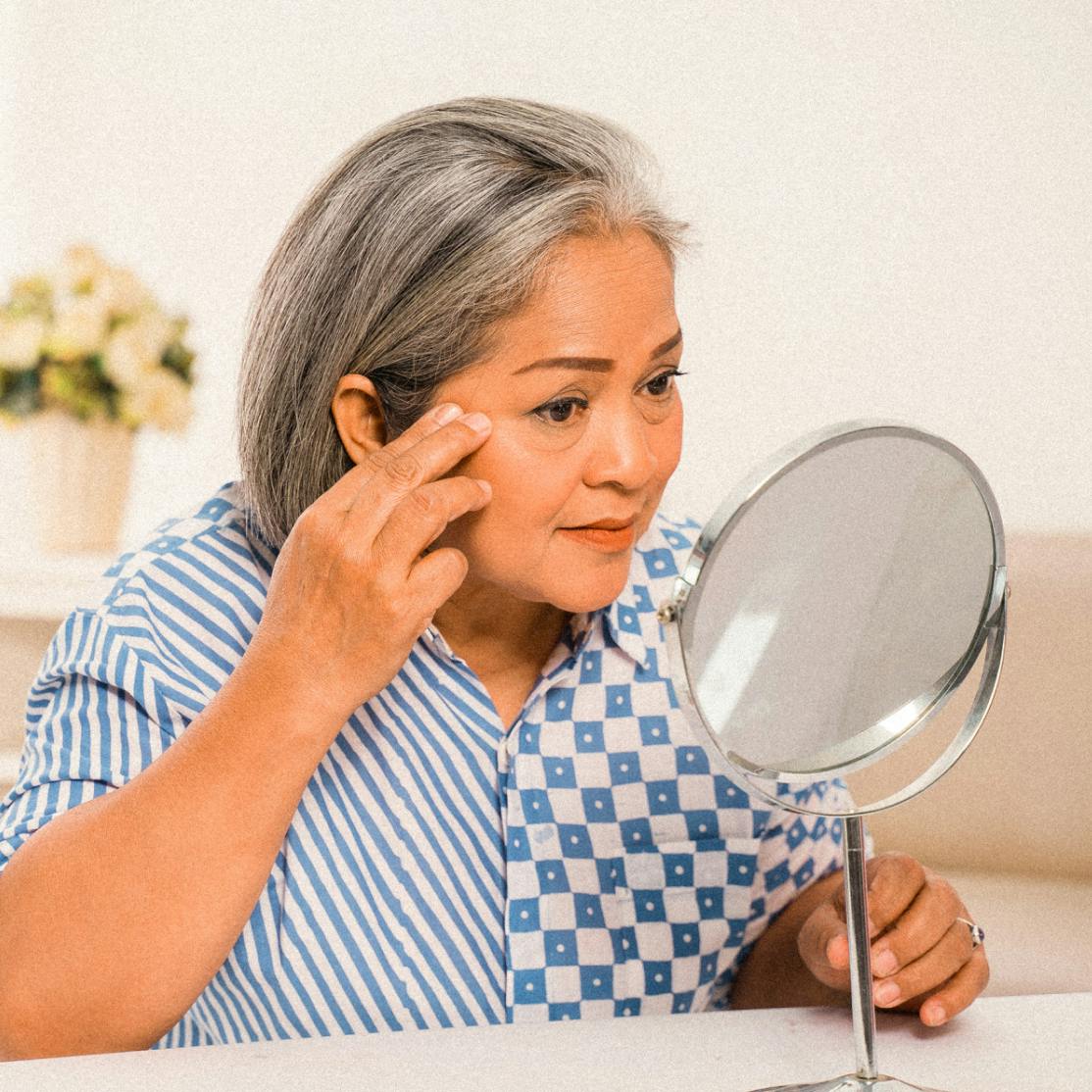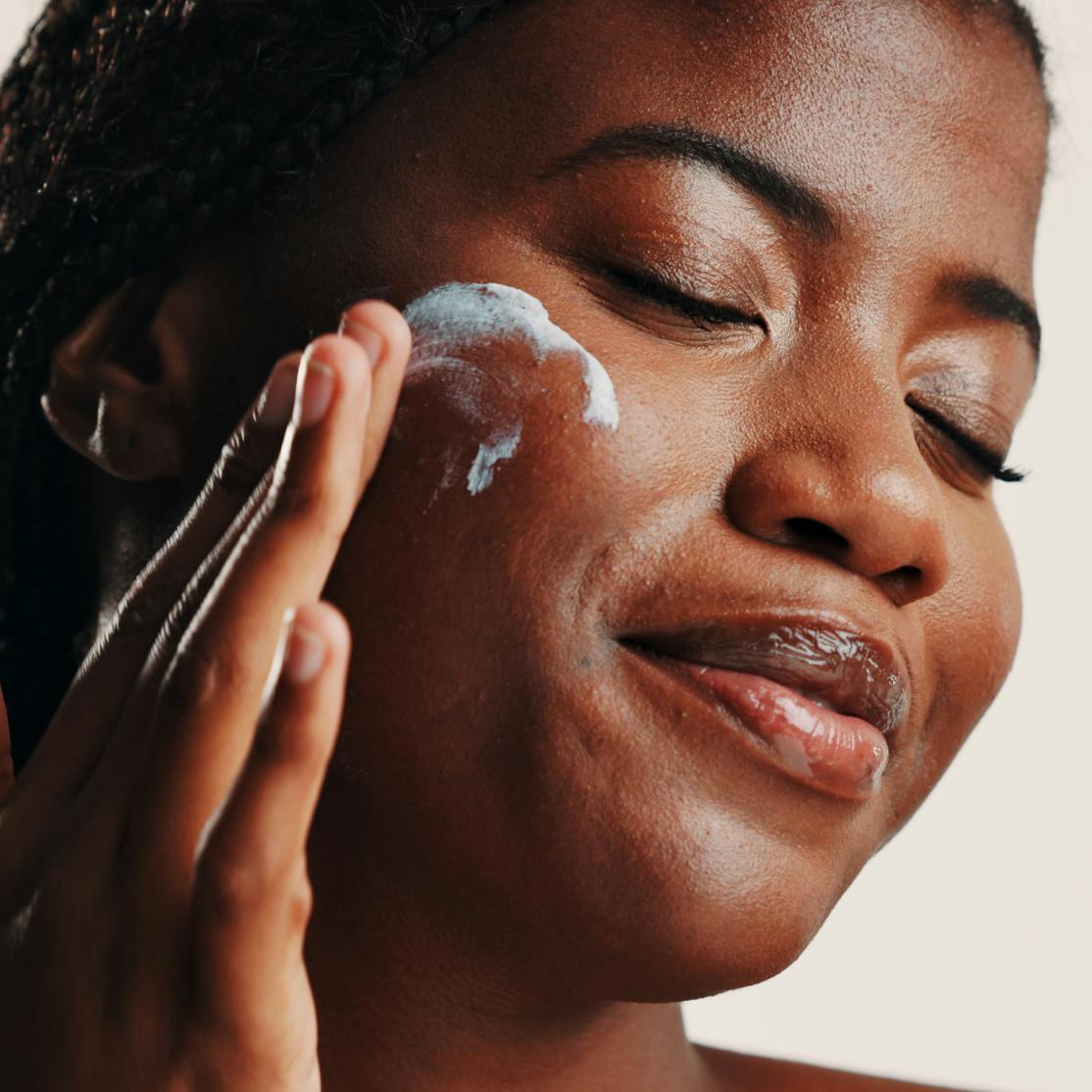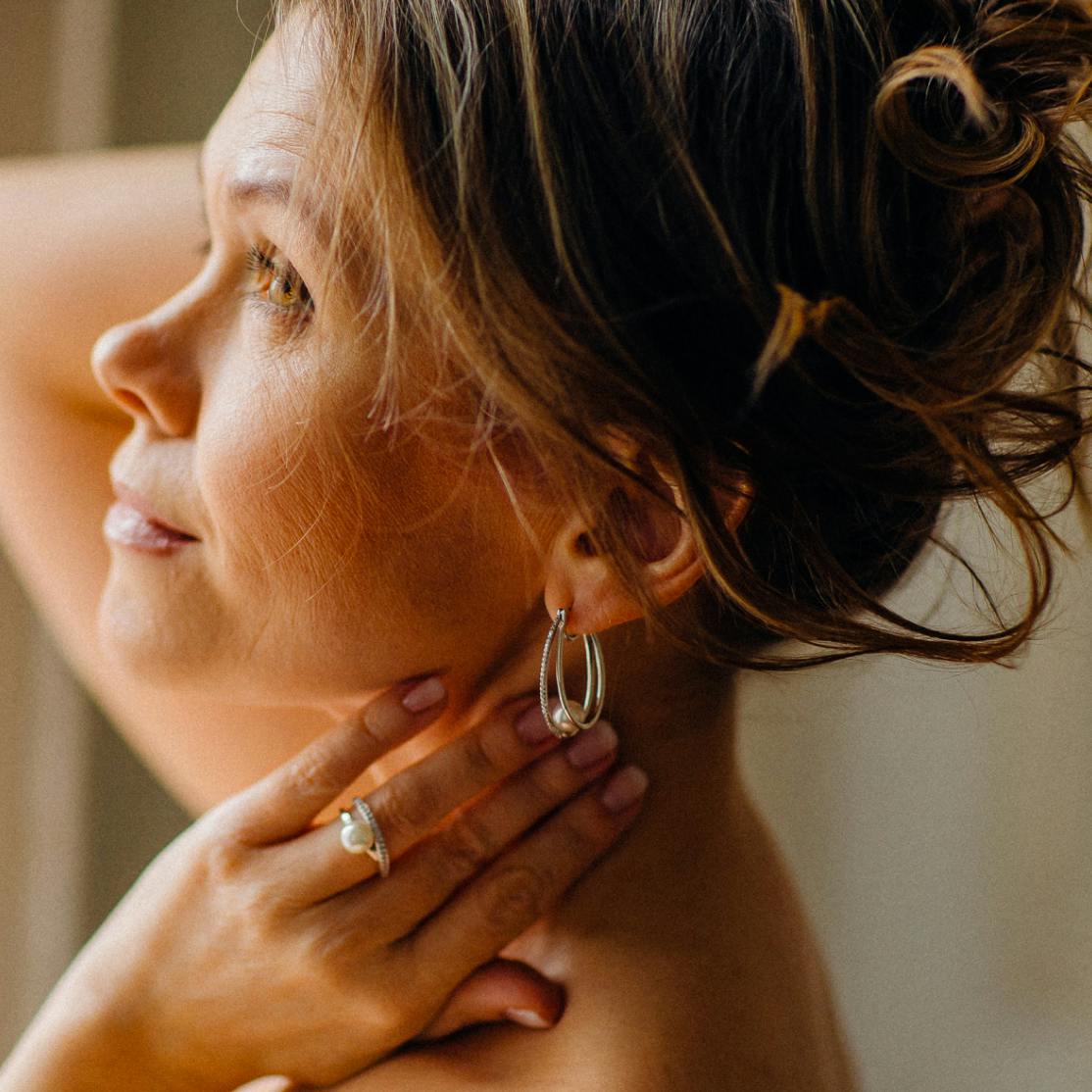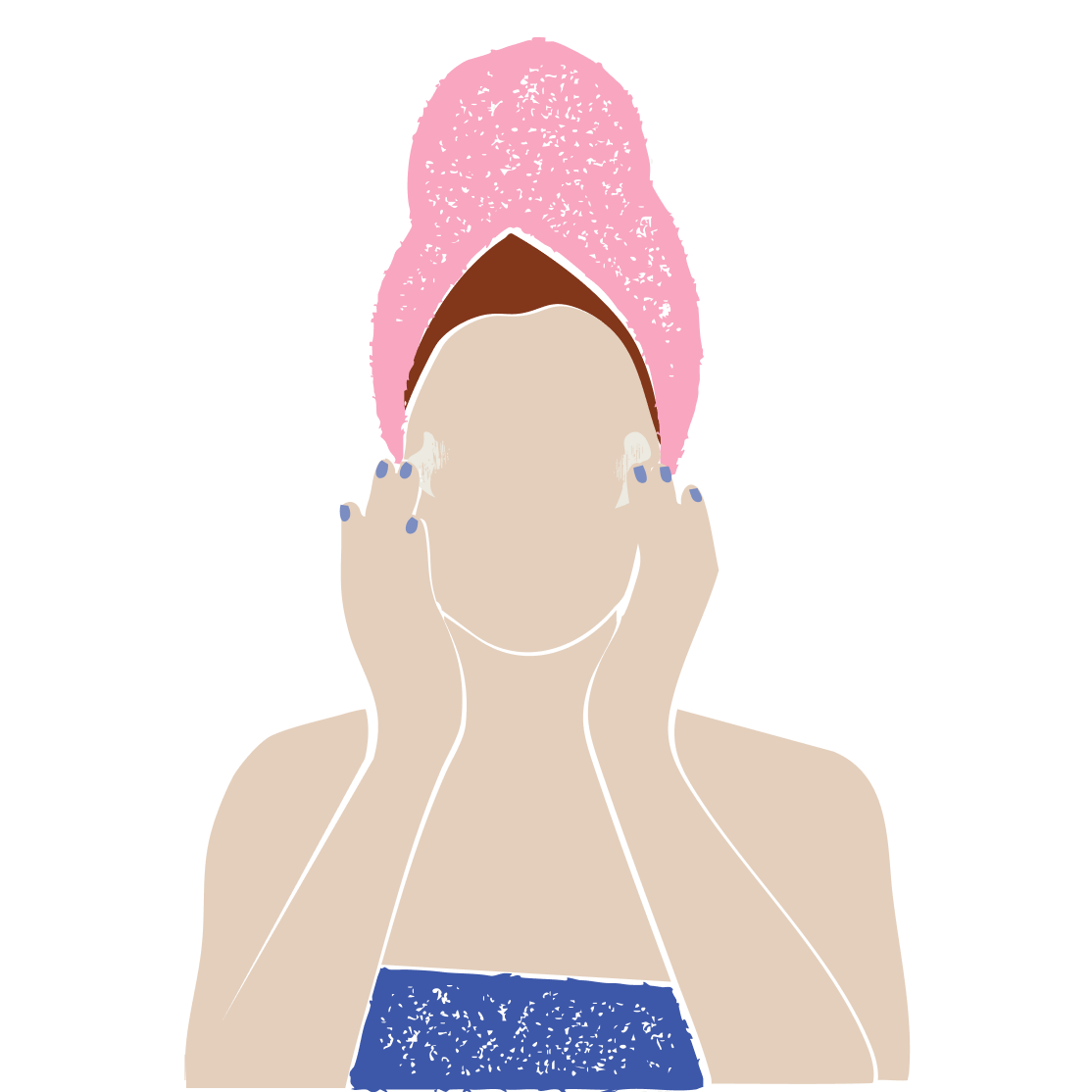If you feel like your skin is screaming “warning! this is a low estrogen face!” you’re not imagining things. Signs of declining estrogen levels during menopause can show up all over your face, dramatically changing how you look and feel. It’s one of the many frustrating fallouts from this massive hormonal shift your body is undergoing. The good news: There’s a lot you can do to restore your glow. And it starts with understanding the connection between your hormones and your skin. Working with a healthcare professional, like a Midi clinician, who can recommend the right products will help you get things back on track.
Understanding Estrogen-Deficient Skin
What Is Estrogen Deficient Skin?
"Estrogen-deficient skin" isn't an actual medical diagnosis—it's really just another term for normal aging. Still, it’s important to understand why it’s happening. When estrogen levels fluctuate and decline during perimenopause and menopause as you approach the end of your reproductive years, your skin can undergo significant changes due to the loss of hormonal support.
What many women don’t realize is that we have estrogen receptors all over our bodies, not just in our reproductive organs. And that includes our skin. So while you may not have made the connection before, high estrogen levels played a key role in allowing you to sail through most of your adult life with generally clear, moisturized, and supple skin. So it’s only natural that things can start to shift drastically when less estrogen is around to help out.
How Estrogen Helps Your Skin
Estrogen supports your skin in several, critical ways, including:
- Collagen production: Estrogen stimulates fibroblasts, the cells responsible for producing collagen, that structural protein that keeps your skin firm and plump.
- Moisture retention: It helps your skin maintain hydration by supporting the skin barrier function. After 40, sebum (oil) production drops significantly, especially for women in menopause. Skin becomes drier, more sensitive, and less able to maintain its moisture barrier—think of it as your skin forgetting how to keep itself hydrated.
- Wound healing: Estrogen accelerates the healing of skin injuries.
- Hair follicle health: It supports your hair follicles, keeping hair growth cycles regular.
Without sufficient estrogen, it's like removing the project manager from your skin's maintenance team—things start falling apart, and nobody knows who's supposed to be handling what anymore. Your skin's organizational chart is suddenly missing its CEO.
Estrogen’s Impact on Skin Elasticity
Your skin's elasticity—that wonderful ability to bounce back after you smile or frown—depends heavily on estrogen. Think of estrogen as your skin's personal trainer, keeping everything tight and toned. From your mid-20s onward, your skin will lose about 1% of its collagen each year.
A nosedive in estrogen means the skin actually becomes thinner, too; your epidermis loses about 6.4% of its thickness every decade.
“There’s also decreased blood flow to the skin, which is why your skin is thinner, dryer, and more vulnerable to bruising, irritation, and dehydration,” says Lauren Streicher, MD, a clinical professor of obstetrics and gynecology at Northwestern University’s Feinberg School of Medicine. You may also notice that your skin doesn't heal as fast from little nicks either, so it’ll break down more easily and heal more slowly.
Interestingly, skin thickness actually fluctuates with estrogen levels throughout the menstrual cycle—which explains why some women notice their skin looks better at certain times of the month. It's not your imagination; it's your hormones giving you a temporary glow-up!
Symptoms and Causes of Estrogen-Deficient Skin
Visible Signs and Underlying Factors
How do you know if your skin is experiencing an estrogen shortage? Look for these telltale signs:
- Dryness: Your skin feels perpetually thirsty
- Thinning: The skin becomes visibly thinner, making blood vessels more apparent and you might even notice that you bruise more easily.
- Wrinkles: Fine lines appear more pronounced, especially around the eyes and mouth..
- Sagging: Loss of firmness in the jawline and cheeks.
- Dullness: Your skin loses its natural radiance, appearing more lackluster.
The underlying cause is straightforward: Decreased estrogen. “Low estrogen causes a 30% decline of your skin's collagen production in the first five years after menopause,” says Dr. Streicher. That's a significant drop in your skin's structural support system. With collagen declining and cell turnover slowing, your skin simply can't maintain the same appearance and texture it once had.
High Estrogen vs. Low Estrogen Face
The contrast between skin with optimal estrogen levels and estrogen-deficient skin can sometimes be striking. Here’s how the presence or absence of estrogen can impact how your skin looks and feels:
Signs of High-Estrogen Skin:
- Plump and hydrated
- Firm with good elasticity
- More resilient to environmental damage
- Even-toned and radiant
- Fuller facial contours
Signs of Low-Estrogen Skin:
- Thin and dry
- Sagging with visible loss of elasticity
- More prone to damage from UV radiation and pollution
- Uneven tone with increased pigmentation
- Hollowing in the cheeks and temples
Professional Treatments for Low Estrogen Skin
Laser Therapy and Skin Rejuvenation Treatments
When your go-to moisturizer just isn't cutting it anymore, professional treatments may offer more significant results for estrogen-deficient skin.
- Laser therapies work by creating controlled micro-injuries in the skin, which stimulate your body to produce new collagen. It's like tricking your skin into thinking it needs to rebuild—and when it does, you get fresher, firmer skin in the process.
- Radiofrequency treatments deliver energy deep into the skin, heating the tissue and stimulating collagen production. Think of it as giving your skin a pep talk through heat—"Wake up! Time to make collagen again!"
- Microneedling creates tiny punctures in the skin to trigger collagen synthesis. While it sounds a bit medieval, it’s typically not that bad (numbing cream helps!) and the results—improved texture and firmness—make it worth considering.
Hormone Replacement Therapy (HRT) for Skin Health
Menopause is considered a time of general "estrogen deficiency." Since this loss of estrogen can impact your skin, HRT may be something you should consider, especially if you’re experiencing other bothersome symptoms like hot flashes, sleep disturbances, low libido, or mood changes. Systemic HRT supplies estrogen and/or progesterone (if you have a uterus) to the body, and it's available in a variety of forms, including pill, patch, gel, and vaginal ring11.
Topical estrogen treatments are another option in which you apply estrogen directly to the skin. This approach targets the skin specifically without affecting the rest of your body as much. Clinical studies have shown that topical estrogen can increase skin collagen content by 38% and skin thickness by 30% over six months1213.
A healthcare provider, like a Midi clinician, can help you decide if HRT is right for you and the best form to start with.
Estriol Face Cream
Among targeted treatments, estriol face cream deserves special attention. Topical use of estrogen has been shown to improve collagen and elastin levels in menopausal women, as well as moisturize the skin. When applied to the face, estriol can help minimize fine lines, plump and tighten skin. More research is needed, but one small study found that topical estriol can increase skin firmness by up to 61% and skin hydration by 38% after just 16 weeks of use. In another study of 59 women, six months of use led to marked improvement in wrinkle depth and pore sizes.
Midi’s Custom Rx formulation also contains hydrating hyaluronic acid and brightening DMAE (dimethylaminoethanol), an anti-aging ingredient. Midi’s Estriol+ Face Cream uses estriol (E3), the weakest of the three estrogen hormones, and does not increase the level of hormones circulating throughout your body when used topically, making it a safe option for most women.
Non-Hormonal Topical Treatments and Skincare Solutions
Effective Care Tips for Low Estrogen Skin
Even without hormone therapy, targeted skincare can help manage the effects of estrogen deficiency on your skin. Think of it as sending reinforcements when your hormonal army has gone AWOL.
Key ingredients to look for:
- Hyaluronic acid: This moisture-binding molecule can hold up to 1,000 times its weight in water. As we age, our natural hyaluronic acid production decreases, making topical application all the more important.
- Ceramides: These lipids help repair and reinforce your skin barrier, preventing moisture loss. They're the construction workers rebuilding your skin's protective wall, but they too decrease with age.
- Retinoids: Retinoid is a term for a range of vitamin A-based products for skin that stimulate collagen production and accelerate cell turnover. Retinol is used to improve uneven skin tone, pigmentation, and texture and it’s available over the counter; tretinoin, aka Retin-A is available by Rx. The downside? Retinols can be irritating at first. Start with a low concentration every few days and work your way up to nightly use for maximum wrinkle-fighting benefits.
- Peptides: These amino acid compounds signal your skin to produce more collagen. Unlike retinol, peptides rarely cause irritation, making them ideal for sensitive skin types that want anti-aging benefits without the drama.
- Vitamin C: This powerful antioxidant protects against free radical damage and supports collagen synthesis18. It's your skin's bodyguard and cheerleader all in one.
And don’t forget sunscreen! “Any dermatologist will tell you the product that is most important for keeping skin youthful is sunscreen, ideally starting around age 20,” says Dr. Streicher. Afterall, UV damage is responsible for approximately 80% of visible facial aging. That's right—all those expensive serums and treatments are fighting a battle that could largely be prevented with consistent sunscreen use.
The American Academy of Dermatology recommends an SPF of 30 or higher. And make sure the products you use are broad spectrum, meaning they block both UVA and UVB rays.
Midi-Recommended Products for Low-Estrogen Skin
In addition to Midi’s Estriol+ Face Cream, Midi clinicians can also recommend non-hormonal skincare products that can help counteract the effects of low estrogen:
- Midi’s Hydroquinone Even Tone Cream: Cells in the skin known as melanocytes produce a pigment called melanin. As we age, the outer layer of our skin thins and melanocytes increase in size, which may lead to dark spots and dark patches on sun-exposed areas of the body. Hydroquinone decreases the melanin production of melanocyte cells and decreases the number of melanocytes, helping to lighten and fade the appearance of dark spots and patches.
- Midi’s Tretinoin Active Renewal Cream: Tretinoin is a retinol that increases cell turnover and stimulates collagen to reveal fresher, smoother skin. Midi’s prescription-strength formula targets multiple skin concerns in a one streamlined step to smooth fine lines and refine texture, visibly brighten and even skin tone, and reduce dark spots, melasma, and sun damage.
Nutrition and Lifestyle Changes for Healthy Skin
Your skin doesn't exist in isolation from the rest of your body. What you eat, drink, and do affects how your skin responds to estrogen deficiency. If your skin could talk, it would be saying, "Hey, that third glass of wine isn't doing me any favors!"
Dietary Approaches
- Phytoestrogen-rich foods: Soy products, flaxseeds, and legumes contain compounds that mimic estrogen in the body. While they're not replacement hormones and the effects may be subtle, research does suggest they may help improve your skin hydration and collagen production.
- Antioxidant-rich foods: Colorful fruits and vegetables can protect against oxidative stress, which accelerates skin aging. One study found that adults who ate foods high in antioxidants had 10% less photoaging over 15 years than those who didn’t eat this type of diet. Load up on berries, leafy greens, and orange produce.
- Omega-3 fatty acids: Found in fatty fish, walnuts, and chia seeds, these help maintain skin barrier function and reduce inflammation.
- Collagen-supporting nutrients: Vitamin C, zinc, and copper are all required for collagen synthesis. Citrus fruits, bell peppers, shellfish, and nuts provide these nutrients.
- Hydration: While it’s hard to trust an A-list actress who claims that her secret to perfect skin is just “water”, it is essential to keeping your skin plump and healthy.
Lifestyle Factors
- Sun protection: UV radiation destroys existing collagen and prevents new collagen formation. Wearing SPF 30+ daily is non-negotiable, plus consider protective clothing and hats.
- Regular exercise: Physical activity increases circulation, delivering nutrients to your skin and removing waste products.
- Stress management: Chronic stress increases cortisol, which further breaks down collagen. Meditation, yoga, or whatever helps you unwind is actually a skincare step.
- Sleep quality: Your skin repairs itself during sleep, with peak regeneration occurring between 11 PM and 4 AM. Getting seven to nine hours of quality sleep gives your skin time to recover from daily stressors.
Avoiding Harmful Habits
- Smoking: Cigarettes contain so many chemicals that harm skin’s structure and lead to more wrinkles and sagging. If you needed another reason to quit, just think of it as the world's most expensive anti-aging cream—in reverse.
- Excessive alcohol: Alcohol use is also associated with increased signs of aging. That glass of wine might help you relax, but it's not doing your skin any favors.
- High-sugar diets: Sugar molecules attach to collagen through a process called glycation, making collagen fibers stiff and brittle. While no one is saying you need to go sugar-free, aim to fill your diet with healthy foods that are low in sugar instead.
Combatting Skin Aging
Strategies for Maintaining Youthful Skin
The most effective approach to estrogen-deficient skin combines multiple strategies. Let’s pull it all together:
- Address hormonal factors: Consider consulting with a healthcare provider, like a Midi clinician, about HRT or alternatives if appropriate for your health status.
- Optimize your skincare: Use products specifically formulated for mature skin, with ingredients proven to address collagen loss and hydration.
- Consider professional treatments: Targeted procedures can provide more dramatic results for severe skin changes.
- Support your skin from within: Nutrition, hydration, exercise, and stress management all contribute to skin health.
- Protect what you have: Sun protection, avoiding smoking, and limiting alcohol help prevent further damage.
Remember: Consistency is key. Your skin didn't lose its estrogen overnight, and you won't restore its youthful appearance overnight either. Think of managing estrogen-deficient skin as a marathon, not a sprint—albeit a marathon where the finish line is more radiant, healthier skin.
Key Takeaways
- Estrogen dramatically affects skin health by influencing collagen production, hydration, and elasticity.
- Low estrogen faces exhibit specific changes including increased dryness, thinning, sagging, and wrinkles.
- Both medical and non-medical interventions can help manage estrogen-deficient skin, from hormone therapy to targeted skincare.
- Supporting lifestyle factors like nutrition, hydration, sleep, and stress management complement skin-specific treatments.
- Consistency in skin care is crucial for maintaining results and preventing further deterioration.
- Consult a clinician to help determine the most appropriate approach for your specific needs and health status.
Frequently Asked Questions (FAQs)
How does low estrogen affect your face?
Low estrogen reduces collagen production, skin thickness, and oil production. This results in increased dryness, more visible wrinkles, sagging, and thinner skin. Many women notice hollowing in the cheeks, more pronounced laugh lines, and a less defined jawline as estrogen levels decline.
What does estrogen deficient skin look like?
Estrogen deficient skin typically appears drier, thinner, and less elastic than skin with optimal estrogen levels. You might notice increased transparency (where blood vessels become more visible), more pronounced wrinkles, less firmness, and a duller complexion.
What are the symptoms of too little estrogen?
Beyond skin changes, low estrogen can cause hot flashes, night sweats, vaginal dryness, mood changes, sleep disturbances, reduced bone density, and changes in body fat distribution. Not everyone experiences all symptoms, and severity varies widely among individuals.
How does estrogen affect face shape?
Estrogen helps maintain facial volume by supporting collagen and fat distribution. As estrogen declines, many women experience a shift in facial fat, with loss of volume in the cheeks, temples, and around the mouth. This can create a more angular, less full facial appearance and can accentuate bone structure in ways that may be perceived as aging35.
If you’re in perimenopause or menopause and want guidance from clinicians who specialize in women’s midlife health, book a virtual visit with Midi today.
Hormonal change is at the root of dozens of symptoms women experience in the years before and after their period stops.
Our trained menopause specialists can help you connect the dots to guide you towards safe, effective solutions.
Whether you need personalized guidance or a prescription routine to tackle symptoms—including brain fog, hot flashes, sleep trouble, mood swings, and weight gain—we’ve got you covered. Learn more here.
Midi’s mission is to revolutionize healthcare for women at midlife, wherever they live and whatever their health story. We believe that starts with education, to help all of us understand our always-changing bodies and health needs. Our core values guide everything we do, including standards that ensure the quality and trustworthiness of our content and editorial processes. We’re committed to providing information that is up-to-date, accurate, and relies on evidence-based research and peer-reviewed journals. For more details on our editorial process, see here.
 Liz Krieger
Liz Krieger







